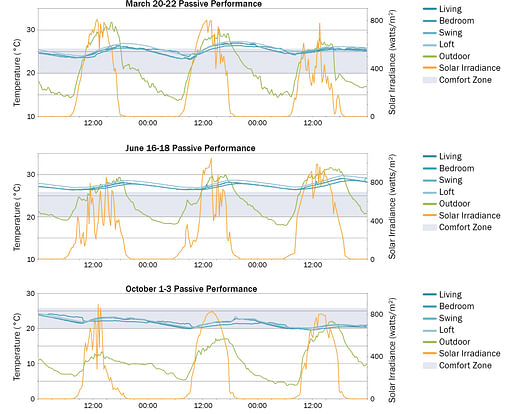
Earlier this week the project team began a seasonal experiment to test the passive performance of the envelope to resist exterior temperatures fluctuations over the course of 72 hours (3 days). To complete this study, the heating and cooling systems are completely disabled for the duration of the period (though the ERV remains in operation to supply code required minimum ventilation).
Earlier forms of this same test have shown interesting returns, generally showing the envelope is able to maintain a steady temperature range. Observations from June remained outside of the comfort zone entirely, however, though night temperatures clearly dropped into the comfort range. Effort by the resident to purge warm interior air in the evenings could have altered this, though high humidities in the Southeast-US often negates such efforts.

We'll keep you posted as to what we find this time around!
The New Norris House is a design/build effort from the University of Tennessee's College of Architecture and Design. Began in 2009, the home was designed and built by UT students in collaboration with Clayton Homes. The built project is now complete and the final phase of the project has begun. A team of 4 people (2 living in the home, and 2 graduate researchers) will rigorously document the experience via qualitative assessments and quantitative measurements, posting results to this blog.





3 Comments
So-do you think the overheating in the summer is due to the microclimate and the operation of the house itself?
Or does it go so far to ask the question if the passivhaus approach is appropriate for the southern USA climate?
I'd be interested to hear a more detailed account of these observations.
We are still digging into the numbers, especially now that we will have 4 distinct cases to compare against.
In terms of being outside of the comfort zone in the summer, I wouldn't necessarily assign this to the operation of the house itself. The maximum fluctuation during the summer study was only 4.5 degrees (F), which is not a lot. With a study this short and such small fluctuations, the temperature at which the 3-day period starts is definitely a big consideration. In this specific example (talking about June still) the average temperature for the 4 zones began at 81.25 (F) and the the average for the entire 3-day period only rose to 81.40 (F). So pretty close to the same!
Additional studies we would like to do this coming summer are to repeat the experiment with a more ideal starting temperature (within comfort range). Based on these results, we would like to perform the test with the resident ventilating at night (again, you can see night temperatures are quite ideal) and closely monitor the RH/ absolute humidity. Though it is not being shown here, we have an equation in our excel file that not only designates comfort zone based on interior temperatures, but also ideal humidity levels for varying temperatures zones.
Humidity is definitely the big concern when we start considering passivhaus approach. And this is all to say again that our ERV was still running continually-- which has some ability to mitigate humidity, but it is not an active process built into our unit.
Hope this helps! We will definitely add some more information on this in the next few days.
1. new norris house is not a passivhaus
2. passivhaus can be achieved in hot/humid locations.
3. passivhaus can be appropriate in hot/humid climates - though it may not be easy to achieve
4. it would appear there is potential for overheating on unshaded glass (south/west/east) which can make for large swings in superinsulated structures. the addition of thermal mass may have limited those swings (e.g. concrete floor). the temp swings out of comfort zone in shoulder season may support that.
5. how warm is the crawlspace getting? as there's no insulation in the floor and very little on the CMU - this could be a source for heat finding it's way into the house. soil temps can hit 25-35C in the southeast during peaks of summer.
6. is there an economizer on the ERV that allows bypassing of heat recovery? (e.g. ultimateair's econocool)
7. it's worth noting that a passivhaus can still be certified as long as overheating is kept to under 10% of annual hours. that's over a month (36 days). this is acceptable to most europeans, most americans wouldn't tolerate it though.
Block this user
Are you sure you want to block this user and hide all related comments throughout the site?
Archinect
This is your first comment on Archinect. Your comment will be visible once approved.